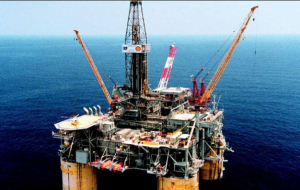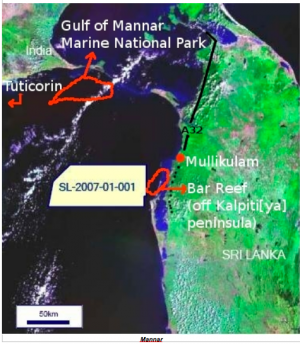 The British Oil Interest in Sri Lanka Phil Miller, 2nd August 2013
The British Oil Interest in Sri Lanka Phil Miller, 2nd August 2013
Oil and gas are about to gush out of the sea around Sri Lanka. Vedanta Resources Plc, a UK-listed company, are set to profit from this long anticipated prospect through their subsidiary Cairn Lanka Pvt Ltd. Both the Sri Lankan government and Vedanta have their critics. Tamil groups are calling for British Prime Minister David Cameron to boycott the Commonwealth Heads of Government Meeting (CHOGM) that is scheduled for November in Colombo, arguing that his attendance will legitimise the Rajapaksa regime’s untold atrocities against their people. Protestors descended on Vedanta’s AGM in London yesterday, highlighting the corporation’s abuse across the Commonwealth, from copper mines in Zambia to the aluminium industry in India: they say it has the worst environmental and human rights record of any company. Despite these campaigns, some poignant questions are yet to be asked. How has a British company with no prior experience in the oil or gas industries, acquired oil fields in Sri Lanka? And what influence will this have on UK politicians visiting the island?
Vedanta is courting controversy over several of it’s metals and mining projects. In Zambia the government has prevented them firing 2000 workers. In Odisha, India, they have just lost their ten year push to mine the sacred Niyamgiri mountains as the indigenous tribe gave a thundering and legally binding vote against it. In Tamil Nadu a major gas leak has cost them a 1 billion rupee fine, and led to mass protests. But there is little news from their oil exploration venture across the sea, under the recently conquered Gulf of Mannar between India and Sri Lanka. The legacy of a thirty year ethnic conflict between Tamil seperatists and the Sinhalese majority is a highly militarised Sri Lankan state, where freedom of the press is curtailed and the independence of the judiciary is under attack. Only yesterday, the Sri Lankan army shot dead at least one civilian and hospitalised 15 others at an environmental protest over contaminated drinking water from a chemical factory. It is an interesting environment for business, to say the least. But not one that appears to bother the delegation of six British MPs who visited Sri Lanka last week, to prepare for the CHOGM. In a discussion with the Economic Development Minister, Basil Rajapaksa (who is also the President’s brother), Tory MP for Epping Forest Eleanor Laing reportedly said “There is a lot of hope for the future. We are very positive about Sri Lanka…one cannot compare human rights in Britain to human rights in Sri Lanka as the island suffered 30 years of war”. That must be reassuring message for Vedanta, Cairn and the Rajapaksa family to hear. Biddingon the second round of Mannar oil blocks has been extended by two months until the end of November – after the CHOGM has taken place. And CHOGM is now a venue for business deals, with the Commonwealth Business Council holding a forum throughout the event about investing in the Commonwealth. One of the sessions is titled “Sri Lanka: 21st Century Business Destination – This session will examine the opportunities in Sri Lanka and provide business views on how to super charge the country’s development”. Sri Lanka’s geographic location at the centre of the Indian Ocean makes it an ideal energy hub.
 There are already reasons to be concerned about Vedanta’s operation in Sri Lanka, particularly given its poor environmental track record. To drill the two initial wells in 2011, they used a fifth-generation ship, the Chikyu Hakken, which had been damaged in the Sendai tsunami and was only repaired after the Mannar drill. The second well, ‘Barracuda’, is at a depth of 4,741 m in 1,509 m of sea water, making it almost 5 km deep. The company proudly announced that their “successful drilling programme – the first in Sri Lanka in 30 years – has established a working petroleum system in the frontier Mannar Basin”. The new oil field is next to a pristine maritime sanctuary off
There are already reasons to be concerned about Vedanta’s operation in Sri Lanka, particularly given its poor environmental track record. To drill the two initial wells in 2011, they used a fifth-generation ship, the Chikyu Hakken, which had been damaged in the Sendai tsunami and was only repaired after the Mannar drill. The second well, ‘Barracuda’, is at a depth of 4,741 m in 1,509 m of sea water, making it almost 5 km deep. The company proudly announced that their “successful drilling programme – the first in Sri Lanka in 30 years – has established a working petroleum system in the frontier Mannar Basin”. The new oil field is next to a pristine maritime sanctuary off
Tuticorin and off Kalpiti[ya]. The drilling started after Vedanta had acquired a 58% stake in Cairn Energy, which owns Cairn India and their subsidiary Cairn Lanka through an entity ‘CIG Mauritius Private Limited’ – suggesting a financial base on the Indian Ocean island tax haven of Mauritius, which is also to be the venue of the next CHOGM, in 2015. The Vedanta/Cairn acquisition required permission from the Indian government, which was secretly lobbied by David Cameron to approve the deal on behalf of Cairn. CEO of Cairn, Sir Bill Gammell, is a powerful Scottish energy industry magnate, and close childhood friend of Tony Blair and George W. Bush. Cairn’s links to Sri Lanka were briefly in the spot light during the Liam Fox/Adam Werritty scandal, when it was found the the duo’s mysterious Sri Lankan Development Trust registered its address at Cairn’s HQ in Edinburgh. The former defence secretary had to resign after controversy surrounding his unofficial meetings with various foreign governments, including the Rajapaksa regime.
Although the drilling waited until after the war had ended in May 2009, the deals were being done before the Ceasefire Agreement had formally broken down in January 2008. US government’s internal communications via Wikileaks show references to Mannar’s energy potential in 2006, commenting “There’s Oil in That There Basin”. A year later, the cables say Sri Lanka “will never get as good a chance to convince the international oil companies that it can be a professional partner in a long-term and mutually profitable process”. Licenses to explore the Mannar basin were sold by the Sri Lankan government at an international roadshow, that started in London during September 2007. In an interview with the BBC after the event, an influential Sri Lankan minister, Sarath Amunugama, Governor of the World Bank Group and the IMF for Sri Lanka, acknowledged that “untapped petroleum deposits” were often found in countries “torn with various political conflicts”, but that “out of all places Sri Lanka is the most stable”, and that this “ should be an added reason to lure investors”. It went without saying that to make Sri Lanka more stable for investors, it would require defeating the LTTE and their maritime fighting capacity – the Sea Tigers – which controlled swathes of territory on land and patrolled their de facto territorial waters. It was just days before the London roadshow, that the Sri Lankan Navy captured the strategic coastal village of Mullikulam.. The military’s spokesperson reportedly said “the establishment of Navy camps in Mullikulam and Silavathura[i] will help provide the much needed security for oil exploration in the Gulf of Mannar region, and will also help block the smuggling of arms and ammunition by the LTTE across the Gulf of Mannar region”. The new navy base in Mullikulam, ‘SLNS Bharana’, would later become the north-western Naval headquarters.
The Royal Navy has close links with their Sri Lankan counterparts. War-time President Mahinda Rajapaksa had his son schooled at Britannia Royal Navy College Dartmouth in 2007, to much fan-fare. What is less well known is that “the Ministry of Defence facilitated the participation of Sri Lankan delegates on approximately 60 training and development programmes with the Armed Forces during 2004-2007”. Although the MOD were reluctant to tell me too much in a Freedom of Information request, they did say that “For example in 2006 two Sri Lankan candidates attended an Exclusive Economic Zone Protection Officer Course in the UK. One of the objectives with regards this course was the hope that by providing this training the UK would be able to assist Sri Lanka rebuild its economy on the back of full use of its fishing grounds” [emphasis added]. The veiled reference to the Sea Tigers maritime capacity is instructive, and the anticipation of their defeat is rather ominous. The EEZ course is 4 weeks long and held at the UK’s Martime Warfare School. It covers slightly more than just fishery protection; anti-piracy, counter smuggling and oil spill response are also on the syllabus. When Rajapaksa was re-elected in 2010, Liam Fox (then Defence Secretary) sent two senior Royal Navy officers to attend his inauguration ceremony.
Another aspect of securing the sea could be the A32, a highway along the north west coast, which previously ran through LTTE occupied territory. It has been extended and reconstructed after the war, but critics of such post-conflict infrastructure projects argue these roads are mainly used by the military to transport troops and supplies necessary for the occupation of Tamil lands (and in this case the sea as well). British engineering firm, Mabey and Johnson, was awarded a contract (outside of tender process) to build bridges along this route. The UK government loaned £80m to Sri Lanka to finance the bridge building project. Mabey and Johnson were later fined for bribery offences committed in numerous other countries.
“From even before the seventies, our parent’s generation in Ceylon, has been hoodwinked, citing petroleum potential in Mannar and nearby Tamil seas. It only contributed heavily to divisions of Tamil polity.
But we now know how massive environmental damage is threatened and gigantic financial scams connecting global tax havens is thrust upon our people, using the very same hydrocarbon ‘potential’.
Poor oppressed Tamil speaking people in Eelam [Sri Lanka] may be currently under military oppression but we in the Tamil diaspora will rise up to the occasion and expose Cairn-India’s and Vedanta’s secretive business”
— Santhors JP, Musician and Tamil activist based in London
David Cameron is planning to attend the CHOGM in Sri Lanka, despite outcry from human rights groups. The Prime Minister will “use his visit to see the situation in the country for himself and be clear on what progress is needed”.